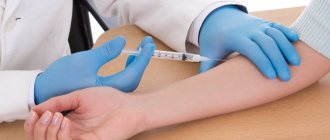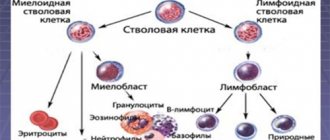Prediabetes is characterized by insulin resistance syndrome, which leads to the development of type II diabetes mellitus.
Insulin is produced by Langerhans cells of the pancreas and is necessary to reduce the concentration of glucose in the blood, thereby maintaining the metabolism of carbohydrates at the required level. When the sensitivity of insulin-dependent cells to insulin decreases, sugar from the blood cannot be absorbed by the cells, which leads to impaired carbohydrate metabolism.
The outcome of this condition with inadequate therapy or its absence becomes type II diabetes mellitus.
IMPORTANT! Every year, 11% of cases of transition from prediabetes to diabetes are recorded.
What are the causes of prediabetes?
The immediate cause of the development of this condition is tissue insulin resistance and impaired insulin synthesis by the pancreas.
There are also many risk factors:
- Physical inactivity (sedentary lifestyle);
- Excessive and unbalanced nutrition;
- Overweight and obesity;
- Inadequate physical activity;
- Diseases of the pancreas;
- Increased cholesterol levels;
- Presence of hypertension and other cardiovascular diseases;
- Bad habits (smoking, excessive alcohol consumption);
- Chronic sleep disorders;
- Stress and psycho-emotional stress;
- Viral infections.
Diabetes mellitus type II (Non-insulin dependent diabetes, Type 2 Diabetes)
Diabetes
Pancreatitis
Hypercholesterolemia
6395 March 22
IMPORTANT!
The information in this section cannot be used for self-diagnosis and self-treatment.
In case of pain or other exacerbation of the disease, diagnostic tests should be prescribed only by the attending physician. To make a diagnosis and properly prescribe treatment, you should contact your doctor. Diabetes mellitus type II: causes, symptoms, diagnosis and treatment methods.
Definition
Diabetes mellitus (DM) type II is a metabolic disease characterized by chronic hyperglycemia (high blood glucose), which develops as a result of disruption of the mechanisms of interaction of insulin with tissue cells or its secretion (WHO, 1999). In people with this form of the disease, the pancreas cannot produce enough insulin, or the body does not use it effectively. Type II diabetes is diagnosed in 90% of people with hyperglycemia.
Causes of type II diabetes mellitus
The key mechanism for the development of the disease is insulin resistance - the immunity of body tissue cells to the action of insulin, a decrease in their biological response to one or more effects of insulin at its normal concentration in the blood. Insulin resistance leads to the inability of muscle and fat tissue to absorb glucose and to a disruption in the synthesis of glycogen (one of the main forms of “reserve” energy in the human body) in the liver.
In a healthy person, the insulin molecule binds to a special receptor located on the cell membrane and ensures the passage of glucose (the main source of energy) into the cell. In a patient with type II diabetes, the ability of insulin to transmit a signal for glucose to enter the cell is lost, as a result of which the cell cannot absorb glucose.
The pancreas, reacting to high blood sugar levels, becomes depleted over time and loses its secretory functions. As a result, the blood glucose level increases and glucotoxicity increases, which leads to damage to many organs and systems of the body and serious long-term complications.
Although there is a genetic component to the development of type 2 diabetes, the main risk factors for the disease are a sedentary lifestyle, excess weight and abdominal obesity (accumulation of fat in the abdomen), and a diet containing too much fat and carbohydrates. Often there is not one, but a whole complex of reasons.
The disease most often develops in people over 40 years of age who are overweight or obese, but can also manifest at a younger age, as well as in people with normal body weight. In Russia, at least 9 million people (about 7% of the population) suffer from type II diabetes.
Classification of the disease
According to the severity of glycemia:
- Mild - self-limited by the patient and does not require outside help.
- Severe - with severe symptoms, loss of consciousness, can only be stopped with the help of strangers and in an emergency.
According to the degree of compensation of carbohydrate metabolism:
- compensation phase
- subcompensation phase,
- decompensation phase.
The International Classification of Diseases, 10th revision,
offers the following classification of type II diabetes mellitus:
E11.2 - type II diabetes with kidney damage, E11.3 - type II diabetes with eye lesions, E11.4 - type II diabetes with neurological complications, E11.5 - type II diabetes with peripheral blood supply disorders, E11.6 - diabetes type II with other specified complications, E11.7 - type II diabetes with multiple complications, E11.8 - type II diabetes with unspecified complications, E11.9 - type II diabetes without complications.
Symptoms of type II diabetes mellitus
A distinctive feature of the disease is its long asymptomatic course. The reason for the patient’s initial visit to the doctor may be various manifestations of micro- and macroangiopathies, leg pain, and erectile dysfunction. Symptoms of type II diabetes often occur when hyperglycemia is already persistent.
Patients may complain of weakness, fatigue during physical and mental stress, drowsiness, and memory loss. With chronic hyperglycemia, the following manifestations of the disease may occur: dry mouth, severe thirst, itchy skin, frequent urination (including at night), furunculosis, fungal infections, poor wound healing, blurred vision (blurred before the eyes) due to vascular damage retina of the eye. As diabetes progresses, the symptoms become more pronounced, and disturbances in the functioning of various organs are observed. The cells of the brain and heart, which suffer first, need glucose and oxygen the most. Excess sugar in the blood leads to obliteration of arterial vessels - they lose elasticity and firmness, the lumen of the arteries narrows. As a result, patients' blood pressure increases and their heart rhythm is disrupted.
Diagnosis of type II diabetes mellitus
Detection of the disease most often occurs accidentally or during a clinical examination. The diagnosis of diabetes mellitus is established based on the level of glycated hemoglobin (HbA1C) in the blood plasma. Glucose molecules penetrate into red blood cells and firmly bind to hemoglobin protein receptors - they glycate it. The more glucose in the blood, the more of its molecules “settle” on hemoglobin, preventing it from transporting oxygen and carbon dioxide. The diagnosis of diabetes is established when the HbA1C level is greater than or equal to 6.5%.
What are the main symptoms of prediabetes?
Prediabetes does not have any pronounced symptoms, which creates a danger for patients, since not everyone succeeds in identifying it before it turns into diabetes.
However, it is still not completely asymptomatic. May be observed:
- weakness, lethargy;
- dizziness;
- increased thirst and polydipsia;
- progressive change in body weight (weight gain or sudden weight loss);
- itching of the skin (especially the scalp);
- blurred vision;
- chronic fatigue;
- depression;
- thrush (a common characteristic symptom for women).
Nutrition during prediabetes
Nutrition tips for prediabetes are not much different from the basics of proper nutrition in principle. The first step is to reduce the total number of calories consumed per day. Limit your intake of sugar and simple carbohydrates. And also choose foods that are low in fat and high in soluble fiber.
The main place in the diet should be vegetables, fish, poultry and whole grains. Red and processed meats, full-fat dairy products and refined grains should be eliminated from your diet. As are sweets.
However, this does not mean that sweets should disappear from life forever. Today there are enough products on the market that use safe substitutes instead of sugar. For example, in our online store you can buy sugar-free jams and desserts, as well as sugar-free and flour-free baking mixes. We also have soups, side dishes, and even low-carb, sugar-free sauces. All of these products will help maintain variety in your diet, reducing its overall calorie content.
How to treat prediabetes? (Prevention of prediabetes)
Knowing the above predisposing factors, you can draw up a plan for preventive measures. First of all, you need to correct your weight, blood pressure and lifestyle. Optimal physical activity, proper balanced nutrition, monitoring blood pressure, timely intake of antihypertensive drugs (lowering blood pressure) and giving up bad habits will help prevent the development of insulin resistance syndrome.
Also an important preventive measure is timely seeking qualified help if such symptoms are detected.
Due to the absence of pronounced specific clinical manifestations, this condition cannot always be recognized with accuracy, so a careful differential diagnosis is necessary.
When this pathology is detected, they are not always in a hurry to prescribe serious glucose-lowering drugs, trying to start with more gentle methods, for example, physiotherapeutic procedures, such as:
- acupuncture;
- hirudotherapy;
- massage;
- Exercise therapy.
When does prediabetes occur?
It is known that the onset and established diabetes is associated with the constant failure of the body to absorb sugar and its accumulation in the blood. As a result, carbohydrate metabolism is disrupted. Elevated sugar levels during blood donation average 6.9 mmol/l.
A normal glucose value is considered to be in the range from 3.5 to 5.5 mmol/l. In this case, deviations of 0.3 mmol/l are permissible, both upward and downward. Prediabetes usually occurs at levels between 5.6 and 6.9. This indicates a glycemic disorder.
What can we conclude?
Prediabetes is a pathological condition characterized by metabolic disorders due to increased tolerance of insulin-dependent tissues to glucose. This condition is not yet a life- and health-threatening diagnosis, but in the absence of adequate and timely diagnosis and effective therapy, it can develop into type II diabetes mellitus.
Prediabetes does not have specific clinical symptoms, which makes it difficult to make a correct diagnosis. To establish the correct diagnosis, careful differential diagnosis is necessary.
Lifestyle changes and treatment of concomitant diseases will help reduce the risk of developing insulin resistance syndrome and, subsequently, diabetes mellitus.
Treatment of prediabetes
If you have been diagnosed with prediabetes, you will have a key role in its treatment and you will have the opportunity to reverse the condition or delay the progression of type 2 diabetes. Losing weight, eating a healthy diet, and exercising regularly are all very effective in preventing or delaying the onset of diabetes, and also reduce your risk of developing other complications such as coronary heart disease or stroke. These may sound simple, but they are very important both for your overall health and for preventing the development of diabetes.
In some cases, in addition to diet and exercise, your doctor may prescribe medications
. But recent studies have shown promising results in preventing diabetes through diet and exercise alone. One large US study (Diabetes Prevention Program) found that making these lifestyle changes was more effective in reducing the risk of developing diabetes than taking medications: Those who lost a small amount of weight (5-10% of total weight body) and exercised, reduced their risk level by 58%. Those who took medication reduced their risk level by 31%.
Antihyperglycemic drugs








